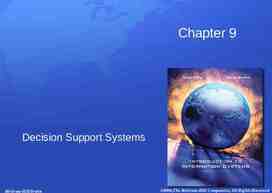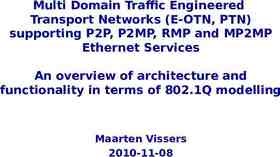Chapter 22 – Project Management Lecture 1 Chapter 22 Project
47 Slides285.41 KB

Chapter 22 – Project Management Lecture 1 Chapter 22 Project management 1

Topics covered Risk management Managing people Teamwork Chapter 22 Project management 2

C o n Software project management c e r n e d w i t h a c t i Chapter 22 Project management 3

Success criteria Deliver the software to the customer at the agreed time. Keep overall costs within budget. Deliver software that meets the customer’s expectations. Maintain a happy and well-functioning development team. Chapter 22 Project management 4

T h e Software management distinctions p r o d u c t i s i n t a Chapter 22 Project management 5

P r o Management activities j e c t p l a n n i n g P r Chapter 22 Project management 6

Management activities People management Project managers have to choose people for their team and establish ways of working that leads to effective team performance Proposal writing The first stage in a software project may involve writing a proposal to win a contract to carry out an item of work. The proposal describes the objectives of the project and how it will be carried out. Chapter 22 Project management 7

R i s Risk management k m a n a g e m e n t i s c o Chapter 22 Project management 8

Examples of common project, product, and business risks Risk Affects Description Staff turnover Project Experienced staff will leave the project before it is finished. Management change Project There will be a change of organizational management with different priorities. Hardware unavailability Project Hardware that is essential for the project will not be delivered on schedule. Requirements change Project and product There will be a larger number of changes to the requirements than anticipated. Specification delays Project and product Specifications of essential interfaces are not available on schedule. Size underestimate Project and product The size of the system has been underestimated. CASE tool underperformance Product CASE tools, which support the project, do not perform as anticipated. Technology change Business The underlying technology on which the system is built is superseded by new technology. Product competition Business A competitive product is marketed before the system is completed. Chapter 22 Project management 9

R i s The risk management process k i d e n t i f i c a t i o n I d Chapter 22 Project management 10

The risk management process Chapter 22 Project management 11

M a y Risk identification b e a t e a m a c t i v Chapter 22 Project management 12

Examples of different risk types Risk type Possible risks Technology The database used in the system cannot process as many transactions per second as expected. (1) Reusable software components contain defects that mean they cannot be reused as planned. (2) People It is impossible to recruit staff with the skills required. (3) Key staff are ill and unavailable at critical times. (4) Required training for staff is not available. (5) Organizational The organization is restructured so that different management are responsible for the project. (6) Organizational financial problems force reductions in the project budget. (7) Tools The code generated by software code generation tools is inefficient. (8) Software tools cannot work together in an integrated way. (9) Requirements Changes to requirements that require major design rework are proposed. (10) Customers fail to understand the impact of requirements changes. (11) Estimation The time required to develop the software is underestimated. (12) The rate of defect repair is underestimated. (13) The size of the software is underestimated. (14) Chapter 22 Project management 13

A s s Risk analysis e s s p r o b a b i l i t y Chapter 22 Project management 14

Risk types and examples Risk Probability Effects Organizational financial problems force reductions in the Low project budget (7). Catastrophic It is impossible to recruit staff with the skills required for the High project (3). Catastrophic Key staff are ill at critical times in the project (4). Moderate Serious Faults in reusable software components have to be repaired Moderate before these components are reused. (2). Serious Changes to requirements that require major design rework Moderate are proposed (10). Serious The organization is restructured so that management are responsible for the project (6). Serious different High The database used in the system cannot process as many Moderate transactions per second as expected (1). Chapter 22 Project management Serious 15

Risk types and examples Risk The time required underestimated (12). Probability to develop the software is High Software tools cannot be integrated (9). High Effects Serious Tolerable Customers fail to understand the impact of requirements Moderate changes (11). Tolerable Required training for staff is not available (5). Moderate Tolerable The rate of defect repair is underestimated (13). Moderate Tolerable The size of the software is underestimated (14). High Tolerable Code generated by code generation tools is inefficient (8). Moderate Insignificant Chapter 22 Project management 16

C o n Risk planning s i d e r e a c h r i s k a n Chapter 22 Project management 17

Strategies to help manage risk Risk Strategy Organizational financial Prepare a briefing document for senior management problems showing how the project is making a very important contribution to the goals of the business and presenting reasons why cuts to the project budget would not be costeffective. Recruitment problems Alert customer to potential difficulties and the possibility of delays; investigate buying-in components. Staff illness Reorganize team so that there is more overlap of work and people therefore understand each other’s jobs. Defective components Replace potentially defective components with bought-in components of known reliability. Requirements changes Derive traceability information to assess requirements change impact; maximize information hiding in the design. Chapter 22 Project management 18

Strategies to help manage risk Risk Strategy Organizational restructuring Prepare a briefing document for senior management showing how the project is making a very important contribution to the goals of the business. Database performance Investigate the possibility of buying a higher-performance database. Underestimated development time Investigate buying-in components; investigate use of a program generator. Chapter 22 Project management 19

A s s Risk monitoring e s s e a c h i d e n t i f Chapter 22 Project management 20

Risk indicators Risk type Potential indicators Technology Late delivery of hardware or support software; many reported technology problems. People Poor staff morale; poor relationships amongst team members; high staff turnover. Organizational Organizational gossip; lack of action by senior management. Tools Reluctance by team members to use tools; complaints about CASE tools; demands for higher-powered workstations. Requirements Many requirements change requests; customer complaints. Estimation Failure to meet agreed schedule; failure to clear reported defects. Chapter 22 Project management 21

Key points Good project management is essential if software engineering projects are to be developed on schedule and within budget. Software management is distinct from other engineering management. Software is intangible. Projects may be novel or innovative with no body of experience to guide their management. Software processes are not as mature as traditional engineering processes. Risk management is now recognized as one of the most important project management tasks. Risk management involves identifying and assessing project risks to establish the probability that they will occur and the consequences for the project if that risk does arise. You should make plans to avoid, manage or deal with likely risks if or when they arise. Chapter 22 Project management 22

Chapter 22 – Project Management Lecture 2 Chapter 22 Project management 23

P e o Managing people p l e a r e a n o r g a n

C o n People management factors s i s t e n c y T e a m m e m b e r

A n i m p o r t a n t Motivating people r o l e o f Chapter 22 Project management 26

Human needs hierarchy Chapter 22 Project management 27

I n s o f t w a r e d e v e l o p m e Need satisfaction Chapter 22 Project management 28

Individual motivation Alice is a software project manager working in a company that develops alarm systems. This company wishes to enter the growing market of assistive technology to help elderly and disabled people live independently. Alice has been asked to lead a team of 6 developers than can develop new products based around the company’s alarm technology. Alice’s assistive technology project starts well. Good working relationships develop within the team and creative new ideas are developed. The team decides to develop a peer-topeer messaging system using digital televisions linked to the alarm network for communications. However, some months into the project, Alice notices that Dorothy, a hardware design expert, starts coming into work late, the quality of her work deteriorates and, increasingly, that she does not appear to be communicating with other members of the team. Alice talks about the problem informally with other team members to try to find out if Dorothy’s personal circumstances have changed, and if this might be affecting her work. They don’t know of anything, so Alice decides to talk with Dorothy to try to understand the problem. Chapter 22 Project management 29

Individual motivation After some initial denials that there is a problem, Dorothy admits that she has lost interest in the job. She expected that she would be able to develop and use her hardware interfacing skills. However, because of the product direction that has been chosen, she has little opportunity for this. Basically, she is working as a C programmer with other team members. Although she admits that the work is challenging, she is concerned that she is not developing her interfacing skills. She is worried that finding a job that involves hardware interfacing will be difficult after this project. Because she does not want to upset the team by revealing that she is thinking about the next project, she has decided that it is best to minimize conversation with them. Chapter 22 Project management 30

T h e Personality types n e e d s h i e r a r c h y Chapter 22 Project management 31

T a s Personality types k o r i e n t e d . T h e Chapter 22 Project management 32

I n d Motivation balance i v i d u a l m o t i v a t i Chapter 22 Project management 33

M o s Teamwork t s o f t w a r e e n g i n e e Chapter 22 Project management 34

I n a c o h e s i v e g r o u p , Group cohesiveness

Team spirit Alice, an experienced project manager, understands the importance of creating a cohesive group. As they are developing a new product, she takes the opportunity of involving all group members in the product specification and design by getting them to discuss possible technology with elderly members of their families. She also encourages them to bring these family members to meet other members of the development group. Alice also arranges monthly lunches for everyone in the group. These lunches are an opportunity for all team members to meet informally, talk around issues of concern, and get to know each other. At the lunch, Alice tells the group what she knows about organizational news, policies, strategies, and so forth. Each team member then briefly summarizes what they have been doing and the group discusses a general topic, such as new product ideas from elderly relatives. Every few months, Alice organizes an ‘away day’ for the group where the team spends two days on ‘technology updating’. Each team member prepares an update on a relevant technology and presents it to the group. This is an off-site meeting in a good hotel and plenty of time is scheduled for discussion and social interaction. Chapter 22 Project management 36

The effectiveness of a team The people in the group You need a mix of people in a project group as software development involves diverse activities such as negotiating with clients, programming, testing and documentation. The group organization A group should be organized so that individuals can contribute to the best of their abilities and tasks can be completed as expected. Technical and managerial communications Good communications between group members, and between the software engineering team and other project stakeholders, is essential. Chapter 22 Project management 37

Selecting group members A manager or team leader’s job is to create a cohesive group and organize their group so that they can work together effectively. This involves creating a group with the right balance of technical skills and personalities, and organizing that group so that the members work together effectively. Chapter 22 Project management 38

M a y Assembling a team n o t b e p o s s i b l e Chapter 22 Project management 39

Group composition Group composed of members who share the same motivation can be problematic Task-oriented - everyone wants to do their own thing; Self-oriented - everyone wants to be the boss; Interaction-oriented - too much chatting, not enough work. An effective group has a balance of all types. This can be difficult to achieve software engineers are often task-oriented. Interaction-oriented people are very important as they can detect and defuse tensions that arise. Chapter 22 Project management 40

Group composition In creating a group for assistive technology development, Alice is aware of the importance of selecting members with complementary personalities. When interviewing potential group members, she tried to assess whether they were task-oriented, selforiented, or interaction-oriented. She felt that she was primarily a self-oriented type because she considered the project to be a way of getting noticed by senior management and possibly promoted. She therefore looked for one or perhaps two interaction-oriented personalities, with task-oriented individuals to complete the team. The final assessment that she arrived at was: Alice—self-oriented Brian—task-oriented Bob—task-oriented Carol—interaction-oriented Dorothy—self-oriented Ed—interaction-oriented Fred—task-oriented Chapter 22 Project management 41

Group organization The way that a group is organized affects the decisions that are made by that group, the ways that information is exchanged and the interactions between the development group and external project stakeholders. Key questions include: Should the project manager be the technical leader of the group? Who will be involved in making critical technical decisions, and how will these be made? How will interactions with external stakeholders and senior company management be handled? How can groups integrate people who are not co-located? How can knowledge be shared across the group? Chapter 22 Project management 42

S m a Group organization l l s o f t w a r e e n g i Chapter 22 Project management 43

T h e Informal groups g r o u p a c t s a s a Chapter 22 Project management 44

G o o Group communications d c o m m u n i c a t i o n s Chapter 22 Project management 45

G r o Group communications u p s i z e T h e l a r g e r t Chapter 22 Project management 46

Key points People are motivated by interaction with other people, the recognition of management and their peers, and by being given opportunities for personal development. Software development groups should be fairly small and cohesive. The key factors that influence the effectiveness of a group are the people in that group, the way that it is organized and the communication between group members. Communications within a group are influenced by factors such as the status of group members, the size of the group, the gender composition of the group, personalities and available communication channels. Chapter 22 Project management 47






